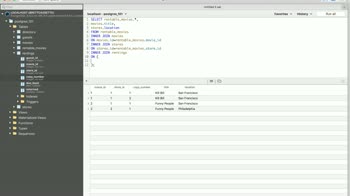
The output of such an item is the concatenation of the first row from each function, then the second row from each function, etc. If some of the functions produce fewer rows than others, NULLs are substituted for the missing data, so that the total number of rows returned is always the same as for the function that produced the most rows. Call a function for each row in select - Postgres.
Ask Question Asked years, 6. So, I want to select all the dates from that table an for each row returne I want to call my function getList to have a result like this:. Select first row in each GROUP BY group? How to implement priorities in SQL ( postgres ). The actual output rows are computed using the SELECT output expressions for each selected row. Using the operators UNION, INTERSECT, and EXCEPT, the output of more than one SELECT statement can be combined to form a single result set. Summary: in this tutorial, you will learn how to use the PostgreSQL ROW _NUMBER() function to assign a unique integer value to each row in a result set.
Introduction to the PostgreSQL ROW _NUMBER() function. Performing SELECT on EACH ROW in CTE or Nested QUERY? This variable will be used to store the rows coming from the query in the main body of the function. The main body does a loop over the group by query stated setting r to each row in sequence.
Let’s examine the syntax of the statement in detail: First, specify the table name where you want to update the data after UPDATE clause. Secon list the columns whose values you want to change in the SET clause. If you update values in multiple columns, you use a comma (,) to separate each pair of column and value. PostgreSQL Column-to- Row Transposition I recently had a need to generate a geolocation history of user activity. Psycopgis a fairly mature driver for interacting with PostgreSQL from the Python scripting language.
It is written in C and provides to efficiently perform the full range of SQL operations against Postgres databases. This page deals with the 2nd version of the driver, not much older psycopg driver. SQL is a language where one task can be solved multiple ways with different efficiency.
This will inform the result parser to bypass. As usual on Postgres and Redshift, window functions make this an easy task. We’ll use the row_number() function partitioned by date in an inner query, and then filter to row_num = in the outer query to get just the first record per group. It queries the widgets table once for each user row and selects that user’s. The ones that are supported in almost all databases are: ROW_NUMBER(): This one generates a new row number for every row, regardless of duplicates within a partition.
How to Get the First Row per Group in PostgreSQL. Let’s say we have an events table that belongs to a user_i and we want to see the first event for each user for that day. The function we need here is row_number.
It’s got a tricky syntax that I always forget. While the open source Postgres database is amazing at running multiple operations at the same time, there are cases in which Postgres needs to block an operation using a lock. If so, it adds in those rows placing NULLs for all the fields of orders. Thus, make sure that each row of the supplier will appear at least once in the result set. While working on a project, I got a requirement to query a specific type of data from a PostgreSQL Table.
It was to fetch the top rows based on a specific value in a row in each category which. Getting based on a cursor. This can be inconvenient for large data sets so the JDBC driver provides a means of basing a et on a database cursor and only fetching a small number of rows. By default the driver collects all the for the query at once.
FOR EACH ROW FOR EACH STATEMENT: Specifies whether the trigger procedure should be fired once for every row affected by the trigger event, or just once per SQL statement. If neither is specifie FOR EACH STATEMENT is the default. A Boolean expression that determines whether the trigger function will actually be executed.
Postgres detects that this is a deadlock and aborts the transaction in S1. To get around this issue, you’ll want to use a variation of FOR SHARE called FOR UPDATE. FOR UPDATE also acquires a locks on the rows being selecte but instead of acquiring read locks on each row, it acquires write locks on each row.
A write lock is similar to a read. In this article, we will learn how to execute a PostgreSQL SELECT query from a Python application to fetch data from the database table using Psycopg2. Also, learn how to process and use result set returned by SELECT Query. Row counts for all tables in a postgres db. GitHub Gist: instantly share code, notes, and snippets.
Otherwise the array will contain one item for each row returned from the query. The PostgreSQL setseed function can be used to set a seed for the next time that you call the random function. Each time you execute the random function, you will get a new random number.
Brak komentarzy:
Prześlij komentarz
Uwaga: tylko uczestnik tego bloga może przesyłać komentarze.